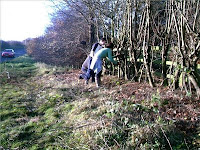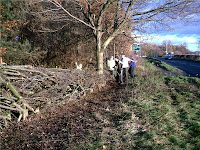 Six volunteers made the one-hour journey to Shugborough, the ancestral home of the Earls of Lichfield, for a workday in the walled garden annexe. We worked with a National Trust archaeologist and 14 of the volunteers from the Wolverhampton group.
Six volunteers made the one-hour journey to Shugborough, the ancestral home of the Earls of Lichfield, for a workday in the walled garden annexe. We worked with a National Trust archaeologist and 14 of the volunteers from the Wolverhampton group.
We spent the day clearing the garden of scrub (alder saplings, ferns and brambles) and burning the debris. Many hands made light work and we cleared a large area. The damp vegetation burned with difficulty and often the garden was thick with smoke.
 Once the scrub clearance has been completed the garden staff will keep regrowth in check so that our efforts don't go to waste. If Lottery money is obtained the aim is to restore the garden to how it looked in 1805 by restoring the mushroom pits and rebuilding the greenhouses. With luck our efforts on Sunday will be the start of a multi-year project similar to the restoration of the pineapple greenhouses in Tatton that we helped complete last year.
Once the scrub clearance has been completed the garden staff will keep regrowth in check so that our efforts don't go to waste. If Lottery money is obtained the aim is to restore the garden to how it looked in 1805 by restoring the mushroom pits and rebuilding the greenhouses. With luck our efforts on Sunday will be the start of a multi-year project similar to the restoration of the pineapple greenhouses in Tatton that we helped complete last year.Thanks to Daniel for the photographs and text





